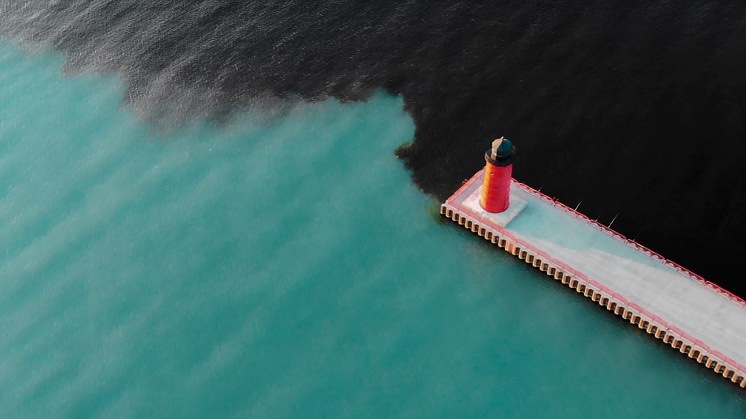Water pollution
Water pollution: how to protect our source of life
The planet keeps nudging us with increasingly extreme droughts, reminding us that water is life. It is an essential resource upon which all living beings depend and it is crucial to all social and economic development, as well as energy production and adaptation to climate change. Nevertheless, we are now facing a gigantic challenge. How do we stop contaminating our rivers, seas, oceans, canals, lakes and reservoirs?

The waters of the River Ganges flow clear and clean through the Indian city of Rishikesh at the gateway to the Himalayas. In these mountains, nobody would guess that this water will be transformed into one of the most heavily polluted rivers in the world, with faecal bacteria levels up to 31 million per 100 millilitres. This is according to reports from Sankat Mochan Foundation, an organisation struggling to restore the Ganges to its former glory. These levels mean that the sacred river has become synonymous with water pollution, a worldwide problem affecting one in every three people on the planet, according to the United Nations (UN).
What is water pollution
The World Health Organisation (WHO) says that polluted water is water whose composition has been changed to the extent that it is unusable. In other words, it is toxic water that cannot be drunk or used for essential purposes like agriculture, and which also causes diseases like diarrhoea, cholera, dysentery, typhoid and poliomyelitis that kill more than 500,000 people worldwide every year.
The main water pollutants include bacteria, viruses, parasites, fertilisers, pesticides, pharmaceutical products, nitrates, phosphates, plastics, faecal waste and even radioactive substances. These substances do not always change the colour of the water, meaning that they are often invisible pollutants. That's why small amounts of water and aquatic organisms are tested to determine water quality.
Main causes of water pollution
It is sometimes caused by nature, such as when mercury filters from the Earth's crust, polluting oceans, rivers, lakes, canals and reservoirs. However, the most common cause of poor quality water is human activity and its consequences, which we will now go on to explain:
 Global warming
Global warming
Rising global temperatures caused by CO2 emissions heat the water, reducing its oxygen content.
 Deforestation
Deforestation
Felling forests can exhaust water resources and generate organic residue which becomes a breeding ground for harmful bacteria.
 Industry, agriculture and livestock farming
Industry, agriculture and livestock farming
Chemical dumping from these sectors is one of the main causes of eutrophication of water.
 Rubbish and faecal water dumping
Rubbish and faecal water dumping
The UN says that more than 80% of the world's sewage finds its way into seas and rivers untreated.
 Maritime traffic
Maritime traffic
Much of the plastic pollution in the ocean comes from fishing boats, tankers and cargo shipping.
 Fuel spillages
Fuel spillages
The transportation and storage of oil and its derivatives is subject to leakage that pollutes our water resources.
Effects of water pollution
Deteriorating water quality is damaging the environment, health conditions and the global economy. The president of the World Bank, David Malpass, warns of the economic impact: "Deteriorating water quality is stalling economic growth and exacerbating poverty in many countries". The explanation is that, when biological oxygen demand — the indicator that measures the organic pollution found in water — exceeds a certain threshold, the growth in the Gross Domestic Product (GDP) of the regions within the associated water basins falls by a third. In addition, here are some of the other consequences:
-
Destruction of biodiversity. Water pollution depletes aquatic ecosystems and triggers unbridled proliferation of phytoplankton in lakes — eutrophication —.
-
Contamination of the food chain. Fishing in polluted waters and the use of waste water for livestock farming and agriculture can introduce toxins into foods which are harmful to our health when eaten.
-
Lack of potable water. The UN says that billions of people around the world have no access to clean water to drink or sanitation, particularly in rural areas.
-
Disease. The WHO estimates that about 2 billion people have no option but to drink water contaminated by excrement, exposing them to diseases such as cholera, hepatitis A and dysentery.
-
Infant mortality. According to the UN, diarrhoeal diseases linked to lack of hygiene cause the death of about 1,000 children a day worldwide.
The impact of water pollution
This type of pollution affects both wealthy and poor countries.

Biological demand for oxygen
-
Contaminated water harms the economy of countries and regions.
-
When the biological demand for oxygen increases, the GDP of the affected regions is reduced by a third.

Nitrogen oxidation
-
Exposure to nitrates at an early age affects development and can even be lethal.
-
Fertilisers are responsible for increasing cases of stunted growth in children by as much as 19%.

Salinity
-
Agricultural yields decrease as the salinity of the water increases.
-
Every year salt water spoils enough food to supply 170 million people.
Source: The World Bank..
 SEE INFOGRAPHIC: The impact of water pollution [PDF] External link, opens in new window.
SEE INFOGRAPHIC: The impact of water pollution [PDF] External link, opens in new window.
Prevention of water pollution
Half of the world's inhabitants will live in water-scarce areas by 2025, so every drop of polluted water today is an irreparable loss for tomorrow. That's why we must prevent water pollution with measures like the following:
- Reduce CO2 emissions to prevent global warming and acidification of the oceans.
-
Reduce the use of chemical pesticides and nutrients on crops.
-
Reduce and safely treat waste water so that, as well as not polluting, it can be reused for irrigation and energy production.
- Restrict the use of single-use plastics that end up floating in rivers, lakes and oceans, many as microplastics.
- Encourage sustainable fishing to ensure the survival of species and avoid depletion of the seas.










